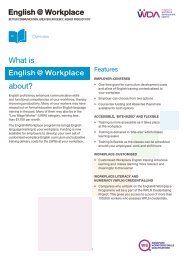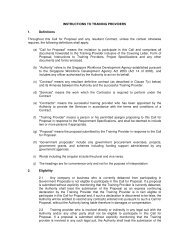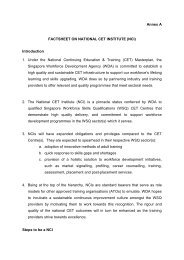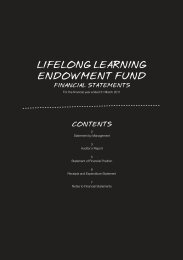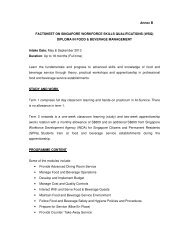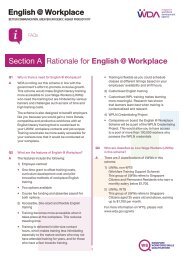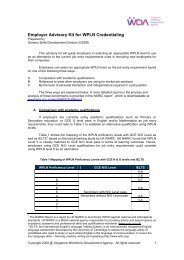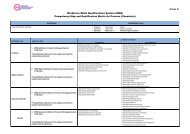(LPM) Workforce Skills Qualifications (WSQ) - WDA
(LPM) Workforce Skills Qualifications (WSQ) - WDA
(LPM) Workforce Skills Qualifications (WSQ) - WDA
- No tags were found...
Create successful ePaper yourself
Turn your PDF publications into a flip-book with our unique Google optimized e-Paper software.
BusinessManagement <strong>WSQ</strong>Leadership & PeopleManagement <strong>WSQ</strong>1 Marina Boulevard#16-01 One Marina BoulevardSingapore 018989Tel: 6883 5885 Fax: 6512 1111Email: wda_enquiry@wda.gov.sgwebsite: www.wda.gov.sgPrinted in August 2013
Calling forT-Shaped ProfessionalsToday’s global economy is dynamic, inter-connected, borderless andcross-functional. Effective professionals, managers, executives and technicians(PMETs) are those who are “T-shaped”. T-shaped Professionals possess verticaldepth of knowledge in a single discipline or profession as well as demonstrate ahorizontal breadth of multi-disciplinary skills, such as strategic planning,leadership, people management, business development and financialmanagement.According to Harvard business professor Dorothy Leonard, T-shapedProfessionals thrive at the workplace because “they are capable of divergent,synergistic thinking.” (Source: Coevolving Innovations- http://coevolving.com/blogs/index.php/archive/t-shaped-professionals-t-shaped-skills-hybrid-managers/)In 2009, the Economic Strategies Committee identified grooming of suchT-shaped Professionals as an imperative for the Continuing Education andTraining of PMETs in Singapore to broaden their skills and increase theiremployability. To facilitate this process, the Singapore <strong>Workforce</strong> DevelopmentAgency (<strong>WDA</strong>) has developed two Singapore <strong>Workforce</strong> <strong>Skills</strong> <strong>Qualifications</strong>(<strong>WSQ</strong>) frameworks:• Business Management (BM) <strong>WSQ</strong>• Leadership & People Management (<strong>LPM</strong>) <strong>WSQ</strong>Horizontal skills acrossvarious functional areas“Through learning interventions such as this programme on strategicplanning, we are building a team of dedicated bankers withstrong skills for the future of banking in Singapore.”David SicariHead of Learning & DevelopmentANZ SingaporeDeep,verticalskills ina singledisciplineThe T-shaped Professional02
Financial ManagementLevelFinanceAccountingCompetency65• Set organisation's finance philosophy and strategies• Endorse financial and treasury management policies,systems, budgets and plans• Develop and establish corporate finance strategies• Develop and establish financial, credit and treasurymanagement policies and systems• Develop and establish financial budget and plans• Evaluate organisation's financial performance• Endorse accounting policies, plans and financial reports• Establish financial reporting process• Evaluate management accounting information• Evaluate tax decisions• Evaluate and interpret financial reports• Evaluate financial audit report findings• Evaluate accounting information systems4 • Manage dividend policies and procedures• Manage credit and treasury operations• Manage budgeting and forecasting processes for thebusiness unit• Manage working capital for the business unit• Manage financial, investment and operating risk• Monitor cash flow reports• Conduct financial analysis of the business unit• Interpret financial valuations• Review and implement financial controls• Review financial reports for accuracy• Manage preparations for financial audit• Prepare management accounting information• Manage accounting information systems3• Perform treasury operations• Prepare credit risk report• Prepare budget for the business unit• Prepare working capital calculations for the business unit• Prepare cash flow report for the business unit• Conduct financial analysis calculations for the business unit• Assist in financial valuation preparations• Prepare consolidated financial reports• Analyse financial statements• Apply knowledge of accounting-related conceptsLevelRisk ManagementEnterprise Risk managementCompetencyBusiness Continuity Management65• Set risk appetite and risk goals• Endorse risk management philosophy and strategies• Endorse the principles of corporate governance andcompliance in the organisation• Establish organisation's risk appetite and risk goals• Establish and develop risk management philosophy andstrategies• Develop a risk management framework, policy and process• Refine risk management policies and processes• Establish risk management commmunication andreporting structure• Establish processes for the management of non-compliance• Establish operational plan to manage environmental risk• Implement leading industry standards• Manage risk across business units• Endorse business continuity framework,strategies, policies and plans• Provide leadership during crisis situations• Develop and maintain business continuity strategies,policies and guidelines• Establish business continuity processes• Establish crisis communication management plan• Develop incident response strategies• Direct management of crisis situations4 • Evaluate and review compliance with applicablelegislation and regulations for the business unit• Operationalise and manage corporate governance policyfor the business unit• Manage and monitor the operation of compliancemanagement requirements and system• Manage risk in the business unit• Promote appropriate risk management activities• Monitor environmental factors to anticipate change and/orimpacts on business function• Conduct crisis assessment• Integrate business continuity management intoorganisation's operations• Develop and implement training roadmap for crisis situations• Manage and implement business continuity plans• Evaluate business continuity plans• Manage crisis situations• Execute a crisis communication management plan• Manage post-event reviews3 • Facilitate compliance with legislative and regulatoryrequirements• Analyse risk management data through the effective useof risk tools• Apply risk management procedures• Analyse organisation's dependencies that may impacton the organisation and an individual's work role• Facilitate the development of business continuitystrategies and plans• Conduct business continuity exercise test• Execute crisis management plan“Building good relationships with colleagues are as important asbuilding one with customers - this is my takeaway from theBM <strong>WSQ</strong> programme on establishing internal and externalstakeholder relationships. I have put into practice active listeningand periodically tracking of team members’ progress so that I candispense help if they are unable to cope. I understand now theimportance of effective communication to achieve win-winsituations, which is vital for the company’s growth.”Benny YapSenior Manufacturing EngineerAffymetrix Singapore Pte Ltd08
Leadership &People Management<strong>WSQ</strong> Framework<strong>LPM</strong> <strong>WSQ</strong>as a ToolkitThe <strong>LPM</strong> <strong>WSQ</strong> framework serves as a career development toolkit for PMETs. Itcan be used for:The Singapore Government’s endeavour to develop and positionSingapore as the global exemplar in human capital management whichattracts and retains talent and investments serves as an impetus to buildleadership capabilities at all levels in the Singapore workforce. Today’sVUCA World of Volatility, Uncertainty, Complexity and Ambiguity alsodemands that leaders themselves must learn new skills to readythemselves for the future.Competency Assessment• Identify critical competenciesrequired at different leadership levels• Create roadmaps for leadershipdevelopmentThe Leadership & People Management (<strong>LPM</strong>) <strong>WSQ</strong> framework focuseson bolstering leadership and people management practices inSingapore. It provides a comprehensive leadership developmentroadmap for PMETs which can also be used as a toolkit for thebenchmarking of corporate leadership capabilities.Developed in consultation with business leaders representing across-segment of industries, the <strong>LPM</strong> <strong>WSQ</strong> framework comprises 27competencies in 6 areas across 4 occupational levels.Competency-based Training• Develop up to 27 competencies inleadership and people managementthrough structured bite-sizedcompetency-based training modules• Keep up-to-date with the latest trends andpractices through peer learning and sharing<strong>LPM</strong> <strong>WSQ</strong>Nationally Recognised Certification• Gain formal recognition through nationallyrecognised Statement of Attainment(SOA) awarded upon completion of eachcompetency-based training programme• Achieve <strong>LPM</strong> <strong>WSQ</strong> qualifications byaccumulating SOAsAn individual would need to complete 6 Core units and 2 Elective units to obtaina qualification. The elective units can be selected from this framework or anyother <strong>WSQ</strong> framework. These can be obtained from within the same level as thequalification or taken from 1 level above or below that level.“Our managers’ leadership skills help impart a strong culture of serviceexcellence. The training they received in building team relationships andpeople management has paid off. It helped push up our standard of serviceseveral notches and kept our attrition rate below 2%. In 2012, the Club alsowon 68 Excellent Service Awards (EXSA) of which 24 were Star Awards, 17Gold Awards and 27 Silver Awards. I truly believe the leadership trainingour team members have gone through is one of the determining factors.”Dr Abdul Rashid (EdD)General ManagerSingapore Recreation Club<strong>WSQ</strong> Level6543List of <strong>LPM</strong> <strong>WSQ</strong> <strong>Qualifications</strong>Qualification<strong>WSQ</strong> Graduate Diploma in Organisational Leadership<strong>WSQ</strong> Specialist Diploma in Leadership and People Management<strong>WSQ</strong> Professional Diploma in Leadership and People Management<strong>WSQ</strong> Advanced Certificate in Team Leadership10
Leadership & People Management<strong>WSQ</strong> Competency MapCORE UNITSELECTIVE UNITSKey AttributesPassion • Initiative • Entrepreneurship • Charisma • Open-Mindedness • Resilience • Dynamism • Reliability • Versatility • IntegrityCompetency CategoryLead with VisionDrive ChangeBuild RelationshipsDevelop People Achieve Results Personal EffectivenessThemes• Direction and strategy• Corporate governance and socialresponsibility• Organisation culture development• Inspiring commitment• Innovation• Process improvement• Identification of change opportunities• Risk taking• Encouraging participation• Building teams• Business networking• Promoting diversity• Conflict management• Coaching and mentoring• Learning and development• Employee engagement• Encouragement• Empowerment• Performance management• Delegation• Accountability• Crisis and risk management• Resource management• Self awareness and development• Ethics• Ambiguity/uncertainty• Role modelling• CommunicationDefinitionLeaders set an inspiring vision for thefuture and align their organisationculture with the vision. They createcommitment and chart a course ofaction that will fulfil the vision.Leaders identify and initiateopportunities for change and enableothers to embrace process andorganisation change. They challengethe status quo and promoteinnovation and create an environmentconducive to change.Leaders establish and maintain awide and relevant network ofcolleagues and strategic partners.They promote the development ofpositive working relationships,respect diversity and develop teamcohesiveness.Leaders proactively seekopportunities to engage their staffand develop their capabilities. Theyshare leadership and develop talentby empowering others andenhancing their ability to perform.Leaders hold self and othersaccountable for achieving results.They organise their resources,provide clear direction, monitorperformance and developcontingencies to achieve the agreedresults.Leaders demonstrate self awarenessand are committed to self developmentto capitalise on their strengths andaddress their weaknesses. Theypromote organisation values and ethicsby role modelling desired behaviours.They persuade and positively influenceothers through effective communication.Graduate Diploma in Organisational LeadershipTransformationalLevel 6• Chief ExecutiveOfficer• DivisionalDirectorLead Organisation• Establish strategic priorities for theorganisation• Drive the development oforganisation vision and culture• Provide organisational leadership,direction and governanceSpecialist Diploma in Leadership & People ManagementLead ManagersLead Change• Build an environment conducive totaking risks• Analyse opportunities for changeand innovation• Apply systems thinking to leadchange and innovationFacilitate ChangeEstablish OrganisationalRelationships• Develop strategic leadershipnetworks• Create a diverse and cooperativework environment• Participate in and support teambuilding initiativesFoster Business RelationshipsGrow Leaders• Identify and groom successors• Support organisational learningand development• Engage all employeesEngage PeopleLead Achievement of Results• Establish business objectives• Establish strategies to manage andreward performance• Monitor organisation performanceFacilitate Achievement of ResultsMaster Personal Effectiveness• Communicate effectively• Persuade and influence stakeholders• Lead decision makingDevelop Personal Effectiveness• Build positive relationshipswith the board• Represent and promote theorganisation• Act as an effective board memberLevel 5• DepartmentHead• Deputy Director• Senior Manager• Contribute to organisationalstrategy development• Develop strategies to comply withcorporate governance requirements• Provide guidance and direction toline managers• Facilitate an environmentconducive to taking risks• Identify opportunities for changeand innovation• Apply systems thinking to facilitatechange and innovation• Develop and maintain business andprofessional networks• Encourage workforce diversity• Manage conflict• Review organisational talentcapability• Develop high potential employees• Engage and support managers• Develop business plans to achievesuccess• Drive the implementation of strategiesto manage and reward performance• Monitor divisional performance• Communicate effectively• Influence management andorganisation decision making• Develop own leadership style andcapabilityProfessional Diploma in Leadership & People ManagementLead TeamManage ChangeCultivate Workplace RelationshipsEnable PeopleManage Achievement of ResultsManage SelfLevel 4• DepartmentManager• Manager• Facilitate implementation oforganisation strategies• Promote compliance with corporategovernance requirements• Provide direction and guidance toteam leaders• Facilitate innovation in theworkplace• Manage the implementation ofchange strategies and processes• Monitor and evaluate impact ofchange on team leaders• Build workplace relationships• Promote workforce diversity• Manage conflict• Identify team leaders’ skillrequirements• Facilitate learning opportunities ofteam leaders• Coach team leaders• Develop team plans• Manage and reward team performance• Monitor implementation of team plans• Communicate effectively• Influence decision making• Demonstrate commitment to selfdevelopmentManagerialAdvanced Certificate in Team LeadershipLevel 3• Supervisor• AssistantManager• Team LeaderSupport Team• Conduct team planning activities• Demonstrate organisational values• Build support and commitmentwithin the teamImplement Change• Identify opportunities for innovation• Implement changes to workpractices• Implement continuous improvementsystems and processesBuild Team Relationships• Participate in networks• Develop team cohesiveness• Resolve conflict within the teamEncourage People• Identify skill development needs• Address skill development needs• Motivate employee independenceand developmentSupport Achievement of Results• Interpret and implement team plans• Manage and reward teamperformance• Monitor implementation of teamplansDevelop Self• Communicate effectively• Lead team decision making• Develop and maintain professionalcompetenceNote : An individual will need to complete 6 Core units and 2 Elective units to obtain a qualification. These elective units can be selected from this frameworkor any other <strong>WSQ</strong> framework. These can be obtained from within the same level as the qualification or taken from 1 level above or below that level.12
Contact our key training providers for information on <strong>LPM</strong>/BM <strong>WSQ</strong> programmes.“After going through the <strong>WSQ</strong> courses on interpersonal skills andteamwork, I see a distinct difference among the team members.They have gone from being “hi-and-bye” colleagues to buddies.They now see the importance of teamwork and work really welltogether. That is a direct benefit we are getting as a result ofthis programme.”Chow Kok LamTraining and Development ManagerCEVA Logistics Singapore Pte LtdCapelle AcademyTel : 6325 4982Email : contactus@capelleacademy.comWebsite : www.capelleacademy.comKaplan ProfessionalTel : 6309 5738Email : enquiry.sg@kaplan.comWebsite : www.kaplan.com.sg/professionalMendaki Social Enterprise Network Singapore (SENSE)Tel : 6478 3100Email : mendakisense_enquiries@mendaki.org.sgWebsite : www.mendaki-sense.com.sgSeraphCorp InstituteTel : 6468 4113Email : wsq@seraphcorp.netWebsite : www.seraphcorp.netSingapore Institute of ManagementTel : 6246 6746Email : funded-prog@sim.edu.sgWebsite : www.sim.edu.sg/funded-progSingapore Institute of Retail Studies/NYPTel : 6222 7477Email : info@sirs.edu.sgWebsite : www.sirs.edu.sgSingapore National Employers FederationTel : 6827 6927Email : trg@snef.org.sgWebsite : www.sgemployers.comSMG Training SystemsTel : 6323 8020Email : enquiry@smgts.bizWebsite : www.smgts.bizTraining Vision InstituteTel : 6325 1068Email : enquiries@trainingvision.com.sgWebsite : www.trainingvision.com.sg: <strong>LPM</strong> <strong>WSQ</strong> Programme Partner: BM <strong>WSQ</strong> Programme PartnerContact us for a full list of programmes and Approved Training Organisations (ATOs).Singapore <strong>Workforce</strong> Development AgencyTel : 6883 5885Email : wda_equiry@wda.gov.sgWebsite : www.wda.gov.sg/lpm_wsq orwww.wda.gov.sg/bm_wsq14





